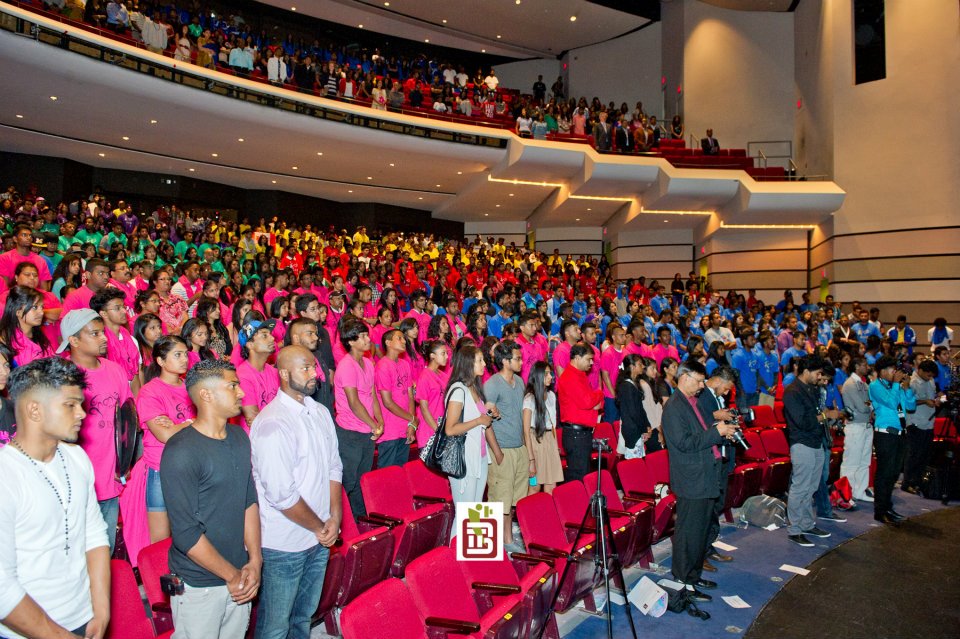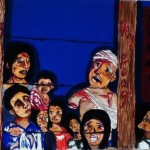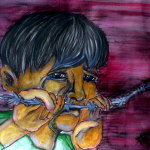Archive for the ‘Speak Out’ Category
Why It Is GenocideBy Editor - January 8th, 2015 |
 |
|
Written by: Priyanth Nallaratnam The Permanent People’s Tribunal last year concluded that what’s happening in Tamil Eelam is an ongoing genocide of Eelam Tamils. This is a historical landmark in the Tamil Eelam liberation struggle for couple of reasons: The independent panel of Jurists recognized the identity of Eelam Tamils in the island, recognized the… |
FAQ: THAALAMBy Admin - May 28th, 2014 |
 |
|
“Culture is the sum of all the forms of art, of love, and of thought, which, in the course of centuries, have enabled man to be less enslaved.” – André Malraux What is Thaalam? Thaalam is a dance competition brought to you by the Arts & Culture Council of Canadian Tamil Youth Alliance (CTYA). Dance is an integral part of art, as it is a form in which individuals are able to express themselves through movement. Through dance, viewers are captivated as they become involved in witnessing a story without words. Individuals or groups of performers unite through dance and it is also often complimented by music and costume. Through Thaalam Tamil youth garnered recognition from the broader Canadian society, which was also the mission of the Arts and Culture Council of CTYA. During a time when the Tamils were portrayed negatively in mainstream media, Thaalam served to showcase the community from a totally different perspective. Thaalam works to preserve the Tamil identity as the Tamil language, culture, and history is being represented and strengthened. Through Thaalam, Tamil dancers have a venue to display their talent and passion for dance. Dance is a powerful tool to showcase our identity and educate the world. How was Thaalam initiated? The Arts and Culture Council of CTYA strives to create an environment for youth that is inspiring and conducive of self-expression through the arts and culture. Among its key objectives are the improvement, re-orientation and expansion of programs that promote the arts and Tamil culture to Canadian Tamil youth and the broader Canadian community. Click for more statements regarding the initiation of Thaalam (Don’t forget to check out the comments on the page): http://ctya.org/blog/ctya-announces-thaalam-2011-an-inter-universitycollege-dance-competition/ What is the Purpose of the Coordinating Committee Members of Thaalam? What are some examples of changes brought forward through the Coordinating Committee Meetings (CCM)? Cash Prize Incentive: In previous competitions, there were no cash prizes incentives. However, through the CCM, the cash prize incentive was recognized as a positive token of congratulations, and that was agreed upon. In fact, the members of the CCM decided the distribution of the cash prize to the first 3 placing teams. 80/20 Rule (Tamils to Non-Tamils Rule): Through discussion, the rule was changed to 2/3s and eventually completely removed after that as the members felt that it was unnecessary. Dancer Fees: The members also changed the dancer fees from $50 – $39 through collaboration and consensus. Other changes include: – The coordinators voted on whether or not to have props and back drops for the competition. – They decided if deadlines are fine to go ahead with or if they needed change. – They requested and agreed how much prop-space should be given to teams. – They discussed and agreed up on what themes should be marked for what percentage. – The CCM also reviewed on what should and should not be included in the rubrics. – They decided upon how much preparation time, practice time, and clean up time should be given. What is the 80/20 Tamils to Non-Tamils Rule? What was the whole issue with the 80/20 Tamils to Non-Tamils Rule? Before the changes were made, UTSG TSA did release a statement at that time about not participating in Thaalam due to the rule. Click here for their statement: https://sites.google.com/a/utsgtsa.com/utsgtsa/news/utsgtsawithdrawsfrominter-universitycollegedancecompetitionthaalam2012duetoguidelinerules Prior to the release of the statement, the CTYA Board of Directors met with UTSG representatives as requested by the UTSG TSA. There were 11 out of the 16 CTYA Board of Directors that were present at this meeting. The information regarding this meeting and the details discussed at this meeting were omitted from the above statement that was released. The following is the extract from the meeting minutes pulled from the 2012 files: b. UTSG TSA meeting i. 5 members came to speak on behalf of UTSG TSA → (The names have been omitted but can be released if requested) ii. They discussed the 80/20 rule of the dance competition. They also said that they do not think the parents/grandparents knowing how to speak Tamil is appropriate because they claimed that in a few generations that might not be applicable. iii. They also said that their reason for challenging the rule is because they have an obligation to their student union and in order for them to continue to receive funding from them, they need to accommodate all of the 42,000 students in any of their initiatives otherwise they could risk losing their funding. iv. They also said that they do not think it is fair for us to want non-Tamils to be active in areas related to Maaveerar naal, may massacre, etc., but not encourage them for other programs. The Board of Directors welcomed the meeting and were open to the points made by the representatives except for one point in section iii. The representative indicated that after speaking to the President of the Student Union at that time, if they were to participate in competitions with such guidelines, they may potentially lose their club status. CTYA found this very concerning and asked the representative to receive a statement in writing from the Student Union. Once the written statement was received, CTYA’s Board of Directors were to take immediate action in changing the rule so that UTSG TSA (and any other TSA) would not be negatively impacted with regards to their club statuses. Unfortunately, the representative did not get back to CTYA regarding this matter and hence the rule was not changed at that particular point in time. It was changed later as described above. Why were there Dancer Fees? Dancer Fees were put in place initially in order to ensure that the dancers have a commitment to their teams. Without dancer fees, a team may even drop out at any moment and jeopardize the status of the competition. However, the Coordinating Committee Members could decide to reimburse dancer fees after the competition was held. This is also why teams do not receive their fees back if they drop out of a competition as it is a commitment made to all the other participating teams. Why did Thaalam 2013 not take place? With the remaining 4 teams, the committee was working to get 2 more new teams to participate in the competition. Unfortunately, as plans for Thaalam 2013 were underway, 2 more of the 4 teams had dropped out. The two teams that did not drop out (York Huskies and Waterloo/Laurier Warriors) were left with not enough teams to compete with. Nonetheless, as these two teams did not drop out of the competition, they will be receiving the dancer fees of $39 that each dancer from these 2 teams did pay. Where is the profit that is generated from Thaalam allocated? The profit that is generated from Thaalam is allocated to the building of a Youth Recreation and Innovation Centre, and the Thazhumbakam – Tamil Genocide Memorial Museum. Thaalam has been held for 3 years already. Why do we not see a centre yet? The Recreation and Innovation Centre and the Thazhumbakam Genocide Memorial Museum is a few million-dollar project. The results of that cannot be seen overnight. Currently, activities and initiatives that will be showcased at the center are being organized by the Councils of CTYA. Some of these initiatives include the following: – Thazhumbakam Mobile Exhibitions – Robotics classes and competitions – Young Writers Network / Poetry Slams, – Weekly Basketball Drop-in Program, – Step UP- Encouraging Women in Sports – Film Arts Workshop CTYA is currently working towards Bridge 101, a youth mentoring program as well as the Young Entrepreneurs Network. Is Canadian Tamil Youth Alliance a Non-Profit Organization? |
May We Remember.By Admin - May 14th, 2014 |
 |
|
May we remember. The month of May creates a sense of calmness, the calmness that follows terror and torture. Here, we present to you, a collection of life incidents, compiled by Anbu from eyewitness accounts. They represent thousands of other stories that have been left untold. Please be advised that these stories contain materials that may be unsuitable for some readers. You may continue to read at your own discretion. The real names of the author and characters in these short stories are not available to public at the moment. Thazhumbkam is obliged to protect the identities of the people involved in these stories and their relatives whom may be in danger should their identities be revealed. Thazhumbakam is a Tamil Genocide Memorial Museum initiated by the Human Rights Advocacy Council of Canadian Tamil Youth Alliance. Pathman: I felt a shell blast near me. When I woke up, two of my friends were lying dead beside me. I tried to get up. I couldn’t. I felt something oozing out of my stomach. I tried to feel the wound and blood started flowing like water out of a tap. Nobody was in sight. Around me, laid tens of lifeless bodies. I crawled as much as I could towards the road. I fell unconscious. When I regained my consciousness, I was only able to hear a few voices. The young voices were that of members of the Tamil Eelam Medical Unit. I heard many people crying and weeping around me. One of the doctors said, “the wound must be in the liver, we can’t do much”. Another female voice said, “No, it looks like the bladder. We should start the treatment”. I lost my consciousness again. When I woke up, it was calm all around me. The place was like a mortuary. Even those with little mobility had forced themselves to leave the place as it was continuing to be target of the army’s shell attacks. I crawled into a bunker space nearby. There were thousands of wounded people in the many bunkers in the sandy beach area around the temporary hospital. Those of us who were not able to walk and those that lost their limbs in the war had no choice but to continue to be in the bunkers. Despite my wound and exhaustion after the surgery, I, along with thousands of others, gathered my energy and tried to walk. After kilometers of walking, I joined many others to be treated in the hospital. I later learnt from those who were in that area, that the army had shot those who were unable to move one by one, and filled the bunkers of unconscious people who did not have any mobility with sand. These memories haunt me even now and I have many sleepless nights. I remember the young face of a boy who encouraged me to leave the bunker saying, “Anna (elder brother), I don’t have both legs. I can’t move. But you can. Try your best to move out of here.” |
Vasuki: The Story of a Young Eelam Tamil GirlBy Admin - May 8th, 2014 |
 |
|
May we remember. The month of May creates a sense of calmness, the calmness that follows terror and torture. Here, we present to you, a collection of life incidents, compiled by Anbu from eyewitness accounts. They represent thousands of other stories that have been left untold. Please be advised that these stories contain materials that may be unsuitable for some readers. You may continue to read at your own discretion. The real names of the author and characters in these short stories are not available to public at the moment. Thazhumbkam is obliged to protect the identities of the people involved in these stories and their relatives whom may be in danger should their identities be revealed. Thazhumbakam is a Tamil Genocide Memorial Museum initiated by the Human Rights Advocacy Council of Canadian Tamil Youth Alliance. Painting by Keera Ratnam Vasuki: The Story of a Young Eelam Tamil Girl There was barely any food left. Starvation, exhaustion and the barrage of artilleries continued on as we feared for our lives. One morning, my mother and my aunt came out of the bunker to help my aged grandmother with her morning routines. Myself (age 13), my sister (age 10) and my brother (age 6) and my cousins aged 4 and 1 and my father stayed inside the bunker. My uncle had died in an air attack on Vaddakachchi last year. So, my aunt left her young children with us and went along with my mother outside the bunker to help my grandmother. As they were outside, a shell fell close to our place and my father peeked out of the bunker and called my mother. My mother and aunt were trying to help grandmother who was unable to run back to the bunker. Just then, another shell blasted closer to our bunker. The continuous barrage of shells continued for a few minutes. We ran outside after the blasts died down. We saw flesh strewn around the bunker. I kept my hands on my mother’s chest. It was a huge hole. My aunt’s head was chopped off. Blood was oozing from my grandmother’s ears. Many others were dead. Shelling continued. We hugged our mother’s body tight and we wept. Father and all of us wept in the bunker. My little cousins could not figure out what had happened to their mother and they cried in fear as well. All five of us were now alone with our father. We stepped out of the bunker after four hours and buried them in a place near the bunker. |
Thangachi’s Corner: Millennial TechnologyBy Admin - April 30th, 2014 |
 |
|
April 30, 2014 Thangachi’s Corner: Millennial Technology Updated every other Wednesday, “Thangachi’s Corner” is a bi-monthly feature that discusses relatable topics and issues relevant to the Canadian Tamil youth of today. For more information about this feature or to suggest a topic, feel free to e-mail us at blogs@ctya.org! Written By: Keerthana Raveendran I am a Millennial—a member of Generation Y. Love of technology. And we sure do love our technology. We are the generation that uses electronics like extensions of our own bodies. Nowadays, you would be hard-pressed to find someone between the ages of fifteen and thirty-five without a cellular phone. And even more noteworthy, most of these folks probably own additional electronics—a laptop, a tablet computer, perhaps even a music-playing device. It didn’t quite bother me how much we rely on our devices until quite recently, having to constantly scold preteen kids to put away their phones before it goes in my desk for the rest of the school day, Mister And these are children. When I was a kid, cell phones were the size of a water bottle, robust, chunky and with an antenna for good measure. And they were solely for the use of adults. It fascinates me that there is such a noticeable disparity between the past ten years of people. Somewhere along the line, technology production and subsequent use soared to the point in which it resulted in an entirely different lifestyle, even within the gap of a decade. I remember being a kid and rushing through my homework in spring just so I could go to the park afterward and play with my friends. I remember not having a television for about a year in grade three, when I really started to write—back then, my desperation for a good story forced me to write my own. I remember summers spent outdoors, and long car rides spent making up games with family, or otherwise laughing and bickering as all children do. We were left to entertain ourselves, and oddly enough, we were never bored. Technology existed back then too. It wasn’t as prevalent or accessible as it is today, but it was there, and somehow, with slow dial-up internet and inconveniently heavy devices, we found a way to live our lives without becoming too dependent. That technology is developing at a rapid rate is both a blessing and a curse. It is a miracle that we can find answers to questions in a matter of minutes, but it’s important to recognize that this convenience comes with a cost. Having become accustomed to immediate results, the newest generation of kids come with a new impatience with every task they face. Having been entertained at every turn, they struggle to engage creativity necessary to solve problems. Kids these days risk overstimulation; they can be both hyperactive and moody. And while with this new wave of selfies, they can be confident and narcissistic, habituation to indoors may leave them lazy to put what could be productive energy to use. But technology has positive effects on the youth of today. Connection to the global landscape leaves Millennials with both an awareness of the events unfolding in the world around them and a sense of social justice to make a positive difference. Technology is a wonderful resource, and we would be fools to forsake it forever. But perhaps a bit of temperance would do us some good. While after all of our conditioning, I don’t know that some of us could go a day without our phones, it is a significant realization not only that we once did, but that people around the world—past, present and future—do it every day. And didn’t we all function fine? Keerthana Raveendran, known by her flock as Thangachi, is an aspiring author whose motivation to write usually kicks in when she’s supposed to be occupied elsewhere. She is an avid procrastinator who sees potential novel ideas as movies in her head. Maybe one of these days they’ll make it onto the page. Thangachi is currently a Masters student studying English at York University. |
The UNHRC Resolution: A Critical InterrogationBy Admin - April 6th, 2014 |
 |
|
Written By: Krisna Saravanamuttu “The struggle for liberation sharpened only because the people realized that they were being taken for a ride. Those same realizations helped keep our struggle on track. If these are to be blunted we will become a race prepared to give up its ideals in return for concessions.” – Taraki Sivaram, former senior editor of TamilNet Five years after the international community, the co-chairs to the peace process, and the United Nations failed to stop Sri Lanka’s 2009 genocide, Tamils appear to finally be upon a new beginning in the decades long struggle for justice. The US sponsored resolution passed an intense session of the United Nations Human Rights Council (UNHRC) last week. The motion carried and supposedly sets up an international investigation into wartime abuses. The fact that some Tamil activists lobbied for this resolution at the Human Rights Council does not preclude a closer, critical, and more constructive interrogation. The question remains, how exactly will the resolution advance Tamil freedom in the international arena? A political solution to end Tamil genocide A cursory glance at the text of the resolution tabled by the United States leaves something conspicuously absent. Besides a vague insinuation to the Sri Lankan campaign to “combat terrorism,” there is not a single mention of the word ‘Tamil’ (not even once). Instead, the resolution declared “its commitment to the sovereignty, independence, unity and territorial integrity of Sri Lanka.” Upon closer scrutiny, minorities and religious groups are mentioned, but still no mention of the unique oppression Tamils suffer. Tamils qualify as a Nation of people, not a minority group, with their own identity, language, culture, history and an identifiable territorial homeland. So any reference to minorities in the UNHRC resolution is irrelevant to the Tamil Question. Indeed, the Tamil People today resist Sri Lanka’s attempts to make them into a scattered minority across their homeland, for the struggle has always been about the survival of the Tamils as a Nation. There are minorities in the island like the Berghers, the mixed descendants of Europeans. What makes us, the Tamils, the target of genocide is that we are a nation with a specific claim to a homeland in the NorthEast. Of course, such arguments are nothing new to the policy makers behind the resolution. Although political will to recognize Tamil Nationhood leaves much to be desired, it is a prerequisite to resolving the island’s conflict. Read More Inside. |
Thangachi’s Corner: Dance CultureBy Admin - March 26th, 2014 |
 |
|
Updated every other Wednesday, “Thangachi’s Corner” is a bi-monthly feature that discusses relatable topics and issues relevant to the Canadian Tamil youth of today. For more information about this feature or to suggest a topic, feel free to e-mail us at blogs@ctya.org! Written By: Keerthana Raveendran When most people talk about their love of dance, they make it sound as if it were love at first sight. As if it were an instinct that sprung to life at first step—almost as if the art form was a part of their very being. But when I first started learning dance at the age of four, I absolutely hated it. Back then, in the nineties, every Tamil girl had to learn how to dance. It was just the thing, though I couldn’t for the life of me understand the beauty of the form. After all, it was hard to feel graceful when it felt like my muscles were being torn apart slowly. And as a kid enrolled in Bharathanatyam classes with about twenty other girls, standing in a row and stomping my feet to the beat of an angry lady hitting a wooden stick on a plank didn’t seem like much fun. And I wasn’t the only one either. In fact, I distinctly remember being in a particular group of friends at dance class at around the age of nine, and the one thread that brought us all together was that fact that we just couldn’t wait to quit. Really, no joke. When one of us did finally manage to quit, when one of us didn’t show up to class for the next few weeks, the rest of us would experience an unpleasant mixture of jealousy and reluctant fascination. In any case, I was never one of those lucky few—no, my dance history went on for years (mostly because much choice wasn’t allotted where that was concerned), and I grew up slowly coming to terms with the fact that I was in it for the long run. It wasn’t until much later that I became invested in dance culture. Was it the performance aspect, do you wonder? Did I perhaps enjoy adorning that gorgeously crafted traditional attire and showcasing my hard-earned skills before a crowd? Nope—performance was my nightmare. But if you asked a dancer what about the art form they loved, they would all give you a different answer. And for me, it was the history that never failed to fascinate. Sure, I enjoyed the crisp visual aesthetics, and I came to appreciate the harsh movements which became a stress reliever long before I realized I needed one. I even loved the aspect of choreography, and would find myself drift off to random music during long bus rides before catching myself choreographing steps to the tune in my mind. But I suppose I liked most the idea of being linked to people well before my time. I liked learning about the evolution of dance over the years, and feeling a sort of connection to these ancestors I will never get a chance to meet. I don’t think I expected for dance to become such an integral part of my life. I’m not sure if anyone does at that age—it’s just something that sneaks up on you. But in light of the successful execution of CTYA’s recent Thaalam 2014, it’s hard to ignore the element of dance when defining our Tamil culture. After all, culture isn’t simply limited to language or festivities—the arts too play a key role in shaping our identity as a society. As renowned Bharathanatyam icon Smt. Rukmini Devi once said, “Dance is a very difficult art to muster, not merely because it has so much to do with physical movements but because the responsibility of the artist is far greater in this art than in any other.” Perhaps that’s also what makes the form worthwhile. A history in dance is not something that just goes away, even years after your last class. It’s in your brain every time you listen to a particularly captivating beat. It’s in that terrible foot-tapping habit you’ve got—the one your mother hates and is always telling you to quit. It’s in your weird tendency to break into a step at the oddest situations. But dance is a reflex now, completely unconscious, done in instinct and born from a restlessness that has now become second nature. Even if you did hate it when you started. About the Author: Keerthana Raveendran, known by her flock as Thangachi, is an aspiring author whose motivation to write usually kicks in when she’s supposed to be occupied elsewhere. She is an avid procrastinator who sees potential novel ideas as movies in her head. Maybe one of these days they’ll make it onto the page. Thangachi is currently a Masters student studying English at York University. |
Thangachi’s Corner: Musings of a New TeacherBy Admin - March 11th, 2014 |
 |
|
Updated every other Wednesday, “Thangachi’s Corner” is a bi-monthly feature that discusses relatable topics and issues relevant to the Canadian Tamil youth of today. For more information about this feature or to suggest a topic, feel free to e-mail us at blogs@ctya.org! Written By: Keerthana Raveendran So in January, I finally transcended my perpetually unemployed status and scored my first grown-up job—as a Core French teacher at an elementary school. It was a pretty big deal, needless to say. And like all newbies, I took the post with excessive zeal, determined to excel and prove my worth in a profession that demanded experience when I had so little to offer. I was as prepared as I ever could have been. I had already volunteered at the same school, so I was familiar with the environment. I had observed the original teacher’s strategies and witnessed successful instruction unfold before my eyes. I had even undertaken supervision of an extra-curricular activity to gain rapport with the students. But though I knew when I started the gig that it wasn’t going to be easy, I didn’t expect the challenges I faced during that first month—the challenges that I still face today (and that I will probably face throughout my career). Every day is a learning experience and success is only experienced in small doses, after copious amounts of trial and error (emphasis on the error). Still, after two months, I’ve managed to extract a few golden morsels of wisdom: |
Thangachi’s Corner: A Change of PaceBy Admin - February 25th, 2014 |
 |
|
February 26, 2014 Updated every other Wednesday, “Thangachi’s Corner” is a bi-monthly feature that discusses relatable topics and issues relevant to the Canadian Tamil youth of today. For more information about this feature or to suggest a topic, feel free to e-mail us at blogs@ctya.org! Written By: Keerthana Raveendran I have always been a planner. I know exactly how my day is going to look the second I wake up, right down to the minute details. I rely heavily on my agenda, and have the next two weeks planned out to the letter. I am forward-thinking when it comes to short term goals, and have a general sketch of the next year or so in the long term. Needless to say, I am fairly organized. And being prepared certainly has its perks. I am almost always on top of things, I get tasks done in an orderly fashion, and I never miss deadlines. I’m hardly ever lost and I have back up plans for my back up plans—just in case. But while preparedness comes with its perks, it has its downsides as well. While it helps to make plans and predictions, life is hardly ever that easy to plot down. Instead, it is a dynamic, spontaneous phenomenon, and the organized person will find themselves at a complete loss when plans suddenly change. Speaking for myself, the planner is someone who wants complete control over their surrounding environment–an impossible feat in its own definition. I often find myself making plans to which I grow attached, and feeling frustrated when unforeseen circumstances intervene. A bit silly? Perhaps. But this a rather difficult statement to digest for those who spend almost all of their time living a few hours ahead of everyone else: A little spontaneity doesn’t hurt anyone. Rephrased—live in the moment. Folks who are more spontaneous tend to be carefree. They are less stressed and are more inclined to enjoy life than their higher-strung counterparts. The key, perhaps, is to find a compromise between the two extremes, a sort of balance. While I couldn’t possibly condone a life of spontaneity with my carefully conditioned, planning behaviour patterns, it is probably a right step in the direction to retreat from plans once in a while and play it by ear. And while it’s okay to have guidelines planned out, a day of impulse will only serve as very welcomed spice in an otherwise bland dish. A change of pace, if you will. |
Thoondal:”Just took my shoes off, ma’am!”By Admin - February 19th, 2014 |
 |
|
Written By: Shayanika Suresh Studying for exams, I often find myself stuck in various coffee shops and libraries for hours at a time. On one such studious occasion, as I was so busily cramming away, I felt a slight tap on my shoulder and I turned to see a face peering at me through large, round glasses. She had a frown on her face, and as she was formulating sentences, I was hastily trying to figure out what I had done wrong, so that I could excuse myself with a simple apology. Unable to find the cause for trouble, I turned to concentrate on what she was saying, “You have to have your shoes on at all times”, I heard her whisper. It took me a few seconds to fully understand what she had just said to me. I had taken off my boots and was sitting cross-legged on the wooden chair. “Yes, yes of course, sorry”, I muttered. She moved on, and I quickly slipped my boots on. The older woman sharing the table with me looked at me in disbelief. “Did she seriously just say that?”, she whispered. I smiled and nodded and turned my focus on the books before me. But I couldn’t help but wonder what the rationale behind such a rule could be. A way to avoid the smell of sweaty socks and feet, maybe? On my way home, I stopped in front of a framed document near the elevators which featured the Rules for Conduct of the library in extremely small font. I wanted to see for myself, if that was indeed a written rule. Sure enough, the rule was there. “All footwear and clothing must be kept on at all times”. If only the document also had an explanation for the rule. On a more serious note, please do not take your shoes off at the library. A rule is a rule, and I wouldn’t encourage you to break the law. CTYA’s Blog has started a new feature every Thursday called ‘Thoondal’, meaning inspiration, stimulation, or inducement. Through these weekly features, the author hopes to inspire you, stimulate your senses and induce you to think deeply about the topics she addresses and finally, to use those thoughts to inspire many more wonderful youth like you. About the Author: Shayanika Suresh is a Law Graduate currently working on establishing her legal career. She is also a passionate writer and has self-published a collection of short stories, “Lips no longer sealed”. Shayanika’s passion to raise awareness of various social issues that affect individuals and society as a whole is evident in her work, leaving a message for the reader to take home. |

